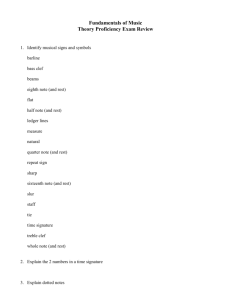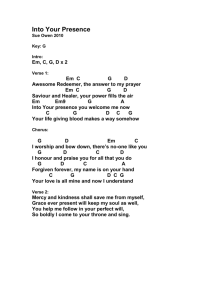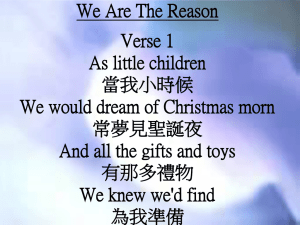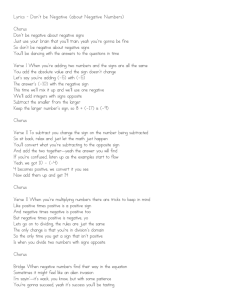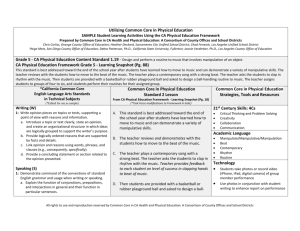Music Vocabulary List
advertisement
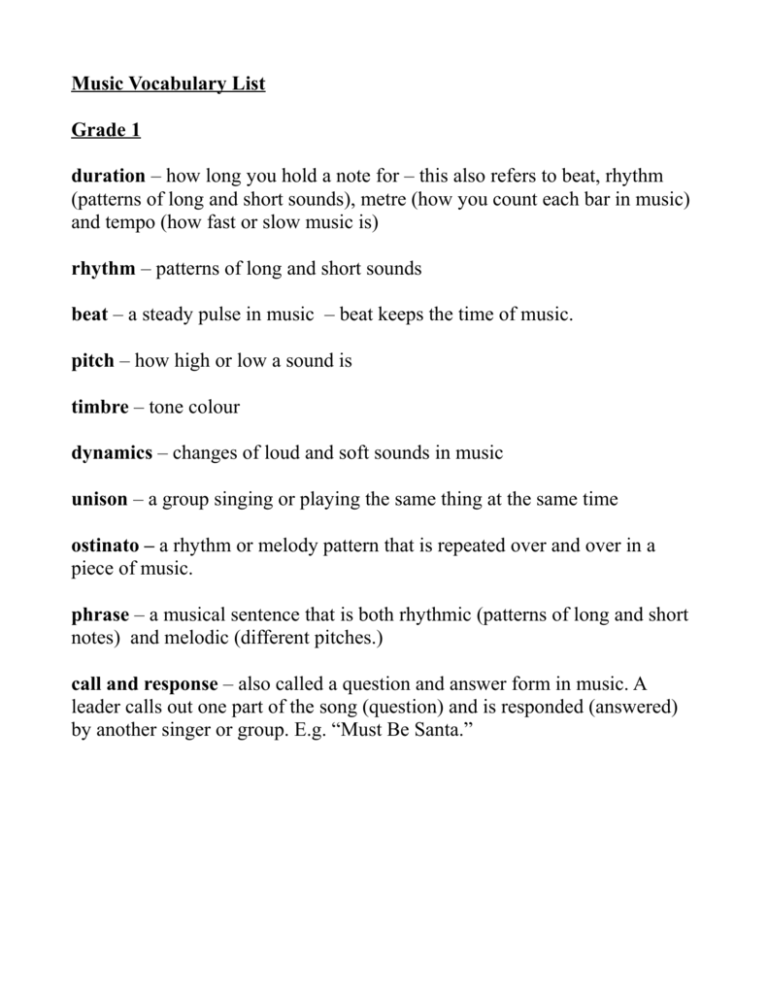
Music Vocabulary List Grade 1 duration – how long you hold a note for – this also refers to beat, rhythm (patterns of long and short sounds), metre (how you count each bar in music) and tempo (how fast or slow music is) rhythm – patterns of long and short sounds beat – a steady pulse in music – beat keeps the time of music. pitch – how high or low a sound is timbre – tone colour dynamics – changes of loud and soft sounds in music unison – a group singing or playing the same thing at the same time ostinato – a rhythm or melody pattern that is repeated over and over in a piece of music. phrase – a musical sentence that is both rhythmic (patterns of long and short notes) and melodic (different pitches.) call and response – also called a question and answer form in music. A leader calls out one part of the song (question) and is responded (answered) by another singer or group. E.g. “Must Be Santa.” Grade 2 piano ( p ) - soft forte ( f )- loud crescendo ( < ) – gradually getting louder decrescendo/ diminuendo ( > ) – gradually getting softer legato - played smoothly staccato – played detached duration – how long you hold a note for – this also refers to beat, rhythm (patterns of long and short sounds), metre (how you count each bar in music) and tempo (how fast or slow music is) rhythm – patterns of long and short sounds beat – a steady pulse in music – beat keeps the time of music. pitch – how high or low a sound is timbre – tone colour dynamics – changes of loud and soft sounds in music unison – a group singing or playing the same thing at the same time ostinato – a rhythm or melody pattern that is repeated over and over in a piece of music. phrase – a musical sentence that is both rhythmic (patterns of long and short notes) and melodic (different pitches.) call and response – also called a question and answer form in music. A leader calls out one part of the song (question) and is responded (answered) by another singer or group. E.g. “Must Be Santa.” binary (AB form) – a piece of music with two different sections. Verse and Chorus – a form of music where the verse part and the chorus part switch back and forth. Verses are usually different. Chorus is the repeated part of a song – and usually the catchier part that people remember. Grade 3 staff – the five lines and four spaces on which the symbols of standard notation of music are written. piano ( p ) - soft forte ( f )- loud crescendo ( < ) – gradually getting louder decrescendo/ diminuendo ( > ) – gradually getting softer presto – very fast largo – very slow legato - played smoothly staccato – played detached duration – how long you hold a note for – this also refers to beat, rhythm (patterns of long and short sounds), metre (how you count each bar in music) and tempo (how fast or slow music is) rhythm – patterns of long and short sounds beat – a steady pulse in music – beat keeps the time of music. pitch – how high or low a sound is timbre – tone colour dynamics – changes of loud and soft sounds in music unison – a group singing or playing the same thing at the same time ostinato – a rhythm or melody pattern that is repeated over and over in a piece of music. phrase – a musical sentence that is both rhythmic (patterns of long and short notes) and melodic (different pitches.) call and response – also called a question and answer form in music. A leader calls out one part of the song (question) and is responded (answered) by another singer or group. E.g. “Must Be Santa.” verse and chorus – a form of music where the verse part and the chorus part switch back and forth. Verses are usually different. Chorus is the repeated part of a song – and usually the catchier part that people remember. section – a part of a larger piece of music that is longer than a phrase (a sentence in music). This could be an introduction, a verse, a chorus, or coda (outro.) coda – an ending section of a piece of music. ternary (ABA form) – a piece of music with three (3) sections: a first section, a second different section and a third section that is the same as the first. Grade 4 staff – the five lines and four spaces on which the symbols of standard notation of music are written. treble clef – the clef used for higher-pitched instruments and voices. Also called the G Clef. bass clef – the clef used for lower-pitched instruments and voices. Also called the F Clef. key signature - The pattern of sharps or flats placed on the staff immediately to the right of the clef to show which notes are to be played sharp or flat throughout a piece of music. time signatures – a numerical symbol showing the number of beats in a bar. The value of the note that gets one beat. For instance 4/4 time means that you have 4 beats per bar. Each beat is worth a quarter note (1 beat). major and minor keys - What distinguishes major keys from minor is whether the third note in the scale is major or minor. The biggest difference is that in the minor scale there is only a half step between the second and third tones as compared to the major scales where the difference between third and fourth note and between the seventh and the eighth note is half. The change in the scale from MAJOR to MINOR changes the mood of the music to sound serious, sad or scary. sforzando ( sfz ) – a sudden or very forceful emphasis – often on a whole chord piano ( p ) - soft forte ( f )- loud crescendo ( < ) – gradually getting louder decrescendo/ diminuendo ( > ) – gradually getting softer presto – very fast largo – very slow legato - played smoothly staccato – played detached duration – how long you hold a note for – this also refers to beat, rhythm (patterns of long and short sounds), metre (how you count each bar in music) and tempo (how fast or slow music is) rhythm – patterns of long and short sounds beat – a steady pulse in music – beat keeps the time of music. pitch – how high or low a sound is timbre – tone colour dynamics – changes of loud and soft sounds in music unison – a group singing or playing the same thing at the same time ostinato – a rhythm or melody pattern that is repeated over and over in a piece of music. phrase – a musical sentence that is both rhythmic (patterns of long and short notes) and melodic (different pitches.) call and response – also called a question and answer form in music. A leader calls out one part of the song (question) and is responded (answered) by another singer or group. E.g. “Must Be Santa.” verse and chorus – a form of music where the verse part and the chorus part switch back and forth. Verses are usually different. Chorus is the repeated part of a song – and usually the catchier part that people remember. section – a part of a larger piece of music that is longer than a phrase (a sentence in music). This could be an introduction, a verse, a chorus, or coda (outro.) introduction – a beginning section of a piece of music coda – an ending section of a piece of music. ternary (ABA form) – a piece of music with three (3) sections: a first section, a second different section and a third section that is the same as the first. repeat – a line or section of music that is repeated. Grade 5 staff – the five lines and four spaces on which the symbols of standard notation of music are written. treble clef – the clef used for higher-pitched instruments and voices. Also called the G Clef. bass clef – the clef used for lower-pitched instruments and voices. Also called the F Clef. key signature - The pattern of sharps or flats placed on the staff immediately to the right of the clef to show which notes are to be played sharp or flat throughout a piece of music. time signatures – a numerical symbol showing the number of beats in a bar. The value of the note that gets one beat. For instance 4/4 time means that you have 4 beats per bar. Each beat is worth a quarter note (1 beat). major and minor keys - What distinguishes major keys from minor is whether the third note in the scale is major or minor. The biggest difference is that in the minor scale there is only a half step between the second and third tones as compared to the major scales where the difference between third and fourth note and between the seventh and the eighth note is half. The change in the scale from MAJOR to MINOR changes the mood of the music to sound serious, sad or scary. sforzando ( sfz ) – a sudden or very forceful emphasis – often on a whole chord piano ( p ) - soft forte ( f )- loud crescendo ( < ) – gradually getting louder decrescendo/ diminuendo ( > ) – gradually getting softer presto – very fast largo – very slow legato - played smoothly staccato – played detached duration – how long you hold a note for – this also refers to beat, rhythm (patterns of long and short sounds), metre (how you count each bar in music) and tempo (how fast or slow music is) rhythm – patterns of long and short sounds beat – a steady pulse in music – beat keeps the time of music. pitch – how high or low a sound is timbre – tone colour dynamics – changes of loud and soft sounds in music unison – a group singing or playing the same thing at the same time ostinato – a rhythm or melody pattern that is repeated over and over in a piece of music. phrase – a musical sentence that is both rhythmic (patterns of long and short notes) and melodic (different pitches.) call and response – also called a question and answer form in music. A leader calls out one part of the song (question) and is responded (answered) by another singer or group. E.g. “Must Be Santa.” verse and chorus – a form of music where the verse part and the chorus part switch back and forth. Verses are usually different. Chorus is the repeated part of a song – and usually the catchier part that people remember. section – a part of a larger piece of music that is longer than a phrase (a sentence in music). This could be an introduction, a verse, a chorus, or coda (outro.) coda – an ending section of a piece of music. ternary (ABA form) – a piece of music with three (3) sections: a first section, a second different section and a third section that is the same as the first. repeat – a line or section of music that is repeated. AABA – form of music that involve the same musical idea the 1st, 2nd and 4th time with a different idea in the 3rd section. ABAC – form of music that have an idea followed by a different idea with a return to the original idea followed by another different idea. rondo – a musical form where the main theme switches with different themes - ABACA OR ABABA. It usually has 5 sections, of which the first, third and fifth are the same or almost the same. Grade 6 staff – the five lines and four spaces on which the symbols of standard notation of music are written. adagio – music to be played slowly allegro – music to be played quickly treble clef – the clef used for higher-pitched instruments and voices. Also called the G Clef. bass clef – the clef used for lower-pitched instruments and voices. Also called the F Clef. key signature - The pattern of sharps or flats placed on the staff immediately to the right of the clef to show which notes are to be played sharp or flat throughout a piece of music. time signatures – a numerical symbol showing the number of beats in a bar. The value of the note that gets one beat. For instance 4/4 time means that you have 4 beats per bar. Each beat is worth a quarter note (1 beat). major and minor keys - What distinguishes major keys from minor is whether the third note in the scale is major or minor. The biggest difference is that in the minor scale there is only a half step between the second and third tones as compared to the major scales where the difference between third and fourth note and between the seventh and the eighth note is half. The change in the scale from MAJOR to MINOR changes the mood of the music to sound serious, sad or scary. sforzando ( sfz ) – a sudden or very forceful emphasis – often on a whole chord pianissimo - ( pp ) - very soft fortissimo - ( ff ) - very loud piano ( p ) - soft forte ( f )- loud crescendo ( < ) – gradually getting louder decrescendo/ diminuendo ( > ) – gradually getting softer presto – very fast largo – very slow legato - played smoothly staccato – played detached duration – how long you hold a note for – this also refers to beat, rhythm (patterns of long and short sounds), metre (how you count each bar in music) and tempo (how fast or slow music is) rhythm – patterns of long and short sounds beat – a steady pulse in music – beat keeps the time of music. pitch – how high or low a sound is timbre – tone colour dynamics – changes of loud and soft sounds in music unison – a group singing or playing the same thing at the same time ostinato – a rhythm or melody pattern that is repeated over and over in a piece of music. phrase – a musical sentence that is both rhythmic (patterns of long and short notes) and melodic (different pitches.) call and response – also called a question and answer form in music. A leader calls out one part of the song (question) and is responded (answered) by another singer or group. E.g. “Must Be Santa.” verse and chorus – a form of music where the verse part and the chorus part switch back and forth. Verses are usually different. Chorus is the repeated part of a song – and usually the catchier part that people remember. section – a part of a larger piece of music that is longer than a phrase (a sentence in music). This could be an introduction, a verse, a chorus, or coda (outro.) coda – an ending section of a piece of music. ternary (ABA form) – a piece of music with three (3) sections: a first section, a second different section and a third section that is the same as the first. repeat – a line or section of music that is repeated. AABA – form of music that involve the same musical idea the 1st, 2nd and 4th time with a different idea in the 3rd section. ABAC – form of music that have an idea followed by a different idea with a return to the original idea followed by another different idea. rondo – a musical form where the main theme switches with different themes - ABACA OR ABABA. It usually has 5 sections, of which the first, third and fifth are the same or almost the same. 12 Bar Blues (I – IV – V) – one of the most popular forms in blues and popular music (rock, pop) using the I (1st) IV (4th) and V (5th) chord progression in a scale. Theme and variations – a form of music in which melody or section of music constitutes the basis (the theme) for a series of variations (small changes in key, metre, rhythm, speed, harmony or mood of the theme.
